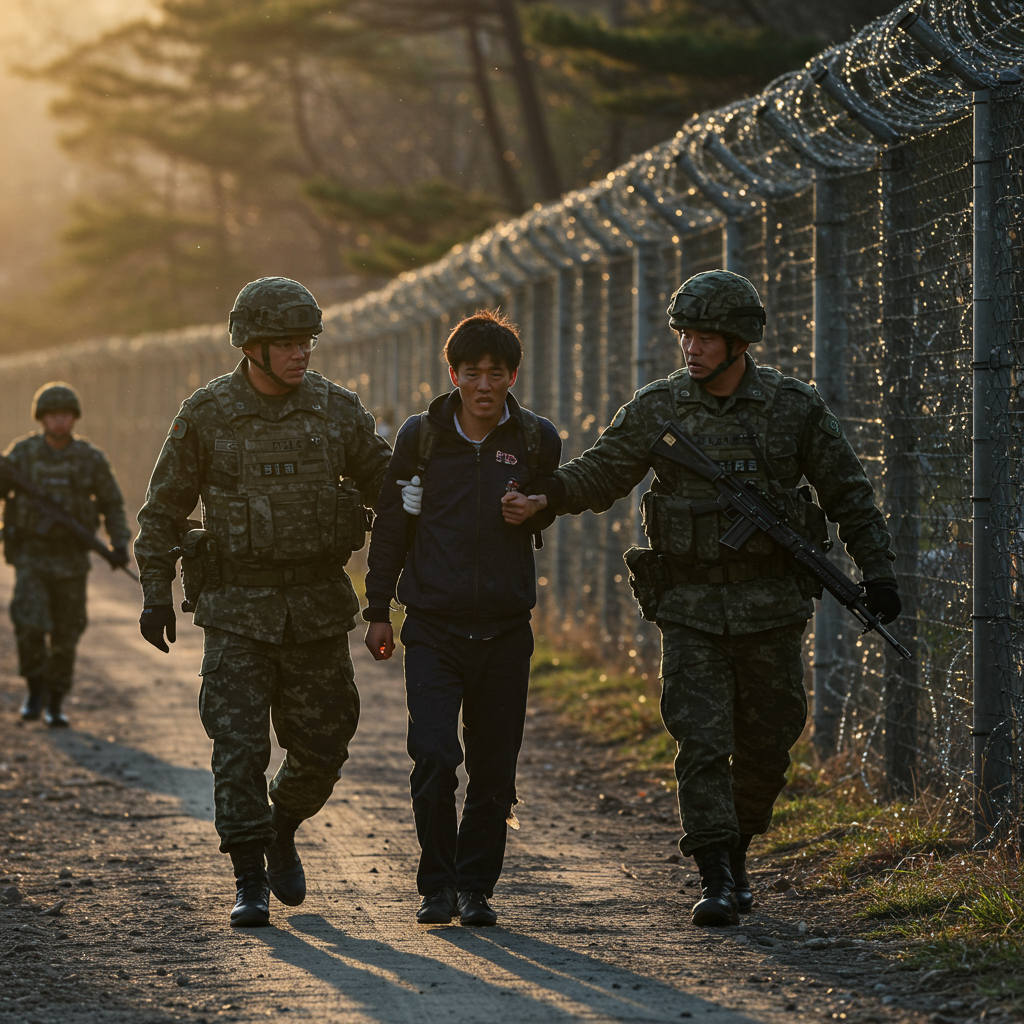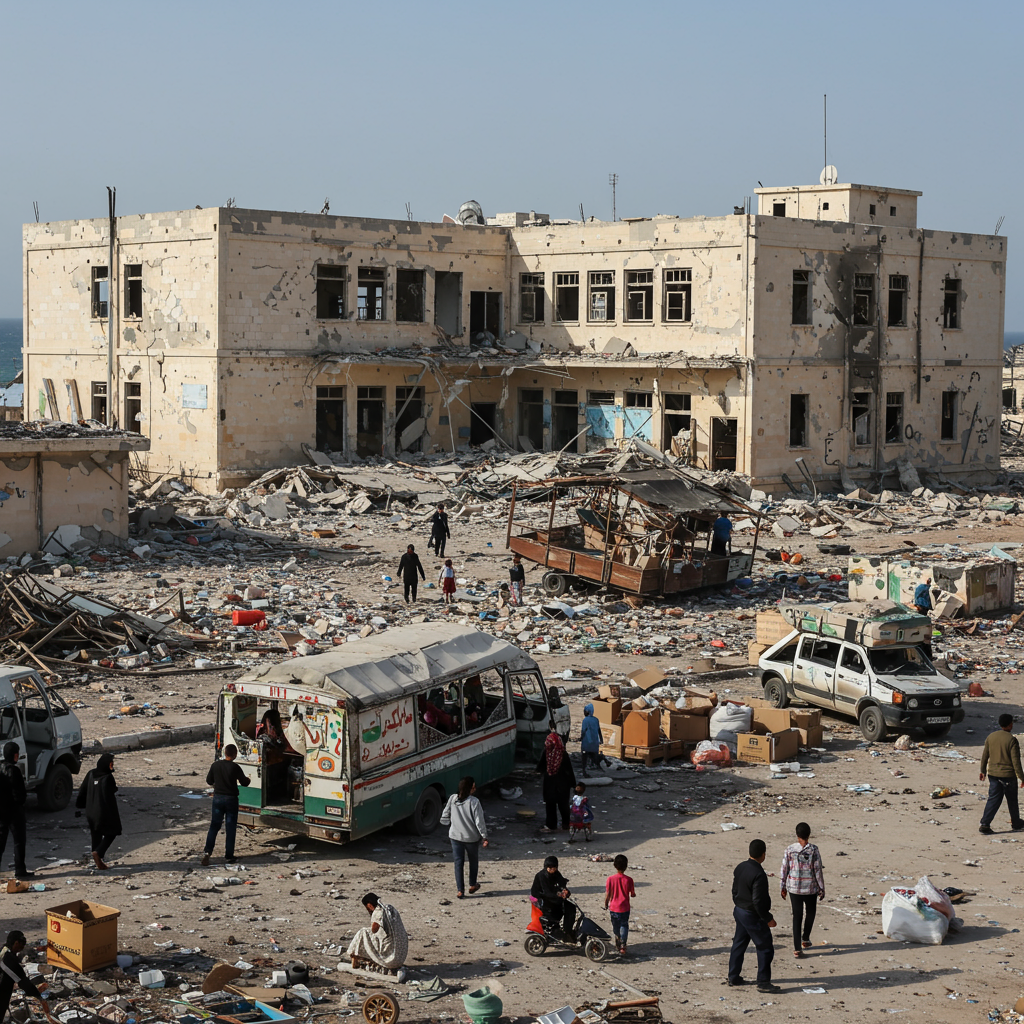In a dramatic and rare event, a north Korean civilian successfully crossed the heavily fortified land border into south Korea this week. Navigating one of the world’s most dangerous frontiers, the individual’s journey highlights the extreme lengths some North Koreans will go to seek freedom despite Pyongyang’s intensified efforts to seal the border. The man was detected and subsequently taken into custody by South Korean military forces after a lengthy operation.
His successful passage through the Demilitarized Zone (DMZ) underscores the enduring challenges of border security along the peninsula, a region technically still at war. While tens of thousands of North Koreans have fled to the South since the Korean War, direct land crossings across the formidable DMZ remain exceptionally uncommon.
The Risky Midnight Crossing
South Korea’s Joint Chiefs of Staff (JCS) confirmed the defector was first detected early Thursday morning, sometime between 3 and 4 a.m. local time. Military surveillance equipment picked up the individual’s presence near the Military Demarcation Line (MDL), the de facto border running through the middle of the DMZ. This detection triggered immediate tracking operations.
The man was located in the midwestern section of the DMZ, specifically in a stream area between Yeoncheon County and Paju in Gyeonggi Province. South Korean troops maintained tracking and surveillance throughout the day. They noted that the defector remained largely still during daylight hours, likely attempting to avoid detection.
The challenging terrain, characterized by dense vegetation and the ever-present threat of landmines, made tracking difficult. South Korean forces initiated their approach under the cover of darkness later that night. The operation to secure the individual involved a significant number of troops navigating the hazardous environment.
When South Korean soldiers made contact near the MDL, the defector reportedly asked, “Who are you?” The troops identified themselves as the Republic of Korea Army and offered safe passage. The man willingly followed their instructions, crossing the MDL and being escorted south out of the DMZ. The entire operation, from initial detection to securing custody and guiding him to safety, took approximately 20 hours.
Navigating the World’s Most Fortified Border
The DMZ serves as a 248-kilometer-long, 4-kilometer-wide buffer zone between North and South Korea. Established after the 1950-53 Korean War ended in an armistice, not a peace treaty, it stands as a tense and dangerous divide. The area is notorious for being one of the most heavily mined regions on Earth. It is also bristling with tank traps, guard posts, and heavily armed troops from both sides.
Crossing this militarized landscape directly presents immense risks from detection, gunfire, and particularly the vast minefields. This is why the overwhelming majority of North Koreans seeking to defect choose a different, albeit still perilous, path.
Typically, defectors travel overland through neighboring China. From there, they attempt to reach a third country, such as Thailand, before finally making their way to South Korea. This indirect route, often involving crossing the Yalu or Tumen rivers into China, is generally considered less immediately life-threatening than attempting to breach the DMZ’s defenses directly.
The success of this latest defection across the land border highlights its extreme rarity and the extraordinary courage or desperation required for such an attempt.
A Potentially Calculated Escape
Evidence suggests the North Korean defector’s crossing may have been a deliberate and methodical undertaking. Authorities believe he strategically exploited specific characteristics of the border terrain. Military sources indicated he appeared to have chosen a section of the border where North Korea’s extensive fortification work had not yet been fully implemented.
Since April 2024, North Korea has been actively reinforcing several frontline regions. This effort includes laying more landmines, reinforcing tactical roads, and erecting structures resembling anti-tank barriers. These actions are seen as stemming from North Korean leader Kim Jong Un’s directives to sever inter-Korean ties. However, South Korean military officials also interpret them as measures aimed at tightening internal controls and preventing defections.
Crucially, this fortification work has often avoided natural obstacles like streams. South Korean defense officials noted that the chosen stream area, with its shallow water and exposed earth, might have been perceived by the defector as easier to navigate and potentially less mined than more heavily fortified sections. This suggests the individual likely planned his route meticulously, seeking out a perceived vulnerability.
Adding to this assessment, the South Korean military observed no unusual movements from the North Korean side during the entire 20-hour operation. This implies Pyongyang’s forces were likely unaware of the crossing while it was happening, thus failing to dispatch a pursuit team.
Context of Rising Border Tensions
This defection occurs against a backdrop of significantly heightened tensions between the two Koreas. Pyongyang recently announced plans to “permanently shut off and block the southern border.” While cross-border travel has been virtually non-existent for years, this declaration, involving cutting off roads and railways, serves as symbolic confirmation of North Korea’s hardened stance and its intent to physically sever connections.
Reports from earlier months confirm North Korea’s intensified activity along the frontier. Seoul noted in July that Pyongyang had spent months laying landmines and erecting barriers, turning parts of the border into a “wasteland.” Disturbingly, the South Korean military also reported in June that North Korean soldiers had suffered “multiple casualties” from landmine explosions in the area – often caused by their own newly laid mines. Signs of demolition on sections of the inter-Korean railway line were also detected in June.
These physical measures are part of a broader pattern of provocation. Recent incidents include North Korea sending over 1,600 balloons filled with trash across the border in late May and early June, prompting South Korea to resume propaganda loudspeaker broadcasts towards the North. Such actions underscore the volatile state of inter-Korean relations.
Investigation and Seoul’s Stance
Following his apprehension, the North Korean defector was taken into custody for detailed investigation. North Koreans arriving in the South through such means are typically handed over to the intelligence agency for thorough screening. This process aims to verify their identity, intent, and gather information about the situation in the North.
The investigation will delve into the specific circumstances of his crossing, including his motive, chosen route, and any potential assistance. The defector identified himself as a civilian, and his ready compliance with the South Korean military upon approach supports the assessment that his intention was indeed to defect.
From a military perspective, the JCS stated that no unusual activities by the North Korean military were detected in response to this specific border crossing incident, suggesting the defection was not part of any larger coordinated action.
This event also takes place early in the term of South Korea’s new President, Lee Jae Myung, who took office the previous month. President Lee has advocated for a more dovish approach towards Pyongyang compared to his hawkish predecessor. He has emphasized the need for reason and logic in handling politics and diplomacy, stating that completely cutting off dialogue is unwise. While this defection is a security matter, it adds another layer to the complex dynamics Lee’s administration is navigating with the North. Broader factors like severe economic hardship and growing disillusionment within North Korea, cited in connection with previous defections, may also be contributing factors driving individuals to take such extreme risks.
Frequently Asked Questions
How did the North Korean man manage to cross the heavily fortified DMZ?
The defector likely chose a specific area along the Demilitarized Zone (DMZ) that he perceived as less fortified, potentially near a stream, to navigate the complex defenses. After being detected by South Korean surveillance early Thursday morning, he reportedly hid during the day before attempting to move south at night. South Korean military forces tracked him and conducted a controlled 20-hour operation to approach him at night, identify themselves, offer guidance, and safely escort him out of the DMZ after he willingly complied.
Why is crossing the DMZ directly considered rare and dangerous compared to other defection routes?
The DMZ is one of the most heavily militarized and mined borders in the world, filled with landmines, barriers, and troops from both sides. Attempting a direct land crossing involves extremely high risks of detection, gunfire, and navigating extensive minefields. In contrast, the typical defection route involves crossing the river border into China, which, while still dangerous, offers a less immediate and concentrated array of military obstacles compared to the direct DMZ breach.
What does this defection reveal about North Korea’s border security and internal situation?
This successful crossing suggests that despite North Korea’s significant efforts since April 2024 to lay more mines and build new fortifications along the border, potential vulnerabilities may still exist, particularly around natural features like streams. It also indicates that North Korean border forces may not have detected the crossing in real-time, highlighting potential gaps in their surveillance or response. Furthermore, such risky defections underscore the severe conditions and potential disillusionment within North Korea that compel individuals to undertake life-threatening journeys to escape.
This rare border crossing serves as a stark reminder of the perilous reality along the Korean peninsula. The defector’s success in navigating the DMZ’s deadly obstacles highlights both the desperation driving individuals to flee North Korea and the ongoing complexities of border security, even as Pyongyang intensifies its control measures and inter-Korean tensions remain high. Investigations into the precise details of his journey will likely provide further insights into the evolving dynamics at the world’s most fortified frontier.



